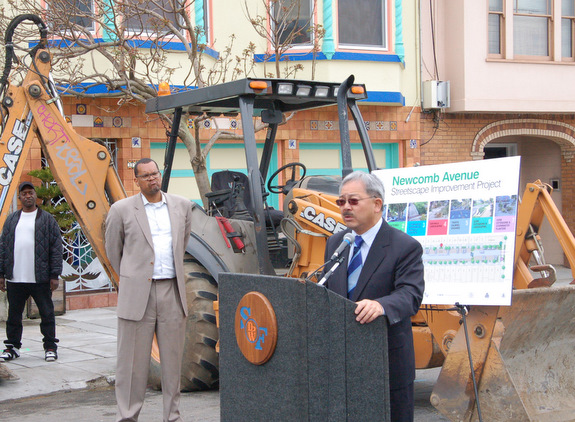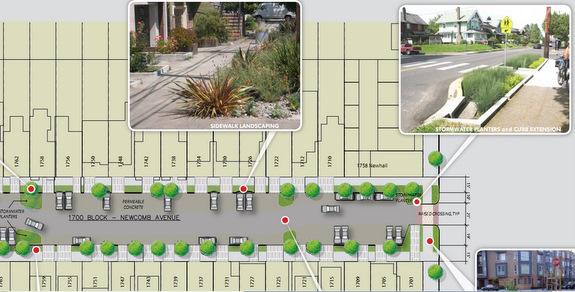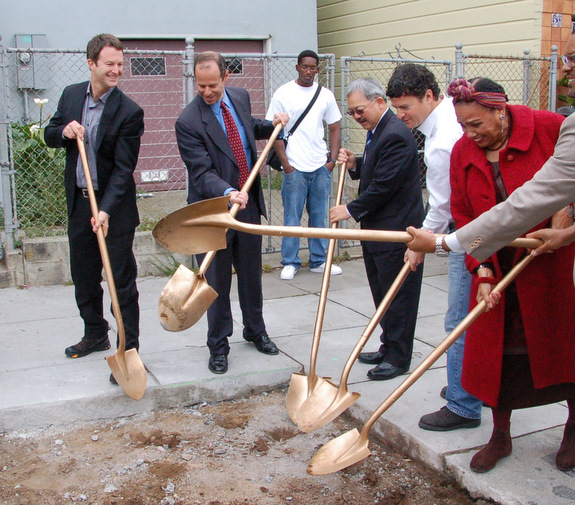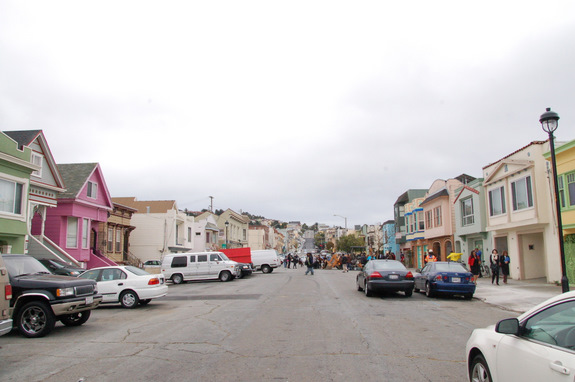
Construction began on a model for sustainable streets in San Francisco today when Mayor Ed Lee and city officials broke ground on a block of Newcomb Avenue in the Bayview District, promising a much friendlier streetscape for residents and the environment.
"You see a vision right in front of your door," Mayor Lee told an audience of residents and agency officials who collaborated on the project. "A vision that's going to bring about slowing the traffic, trees, permeable landscaping - all kinds of things that you see other neighborhoods get."
The treatments in the Model Block project [pdf], such as greener sidewalks and bulbouts, over twenty trees, raised crosswalks, and chicaned street parking with permeable pavement, aim to treat stormwater as it falls, enhance the public realm, and create a safer street by calming motor traffic.
"This is one block of our many streets of San Francisco that altogether cover 25 percent of our city," said Department of Works Director Ed Reiskin. "But they were designed more for people to drive through than to be on, and to cover up the environment rather than to work with its natural processes."
The innovative practice of treating stormwater with streetscape plantings, known as greenstreet treatments, has been commonly used in Portland, Oregon. That city lacks more expensive infrastructure like San Francisco's rainwater storage facilities and controlled combined sewage system, which are not always able to handle loads of rainwater that fall on the streets.

"Since the Gold Rush, 90 percent of the wetlands in the bay have been filled in," said U.S. Environmental Protection Agency (EPA) Regional Administrator Jared Blumenfeld. "Those wetlands act as a filter for all the water that goes into the bay. When you don't have that filter, you need to recreate one."
The EPA provided $500,000 of the project's $1.6 million cost. Mayor Lee and other officials praised the coordination between agencies all the way up to the federal level.
"I think this will really push the conversation forward in how we ought to be designing our streets. This really is a complete neighborhood street," said Andres Power, the project manager for the SF Planning Department.
"[This project] brought together things that we're not supposed to want as people of color in the community. We're not supposed to care about ecology or storm drainage containment. We're supposed to be complacent and not feel like we can be activists and make a change." -Resident Michelle Mouton
"In the Bayview, we're coming up with a strategy to spread these types of improvements out as much as we possibly can as part of the work the SF Redevelopment Agency's doing at roughly half the cost," he added.
Stormwater runoff on the block is expected to be reduced by about half, showing the huge potential for the city to save on expensive management costs.
Located near Third Street between Newhall and Phelps Streets, the block of Newcomb Avenue will put to the test a template on which future streetscape redesigns could be based in a neighborhood historically neglected for street improvements.
Power said the block was chosen after neighbors organized in response to the SF Redevelopment Agency's Model Block Project request for proposals, which sought to invest in existing Bayview communities for its pilot program.
"They really sold the city on why this block is the best to move forward with," he added.
"I finally feel like we're kind of being noticed," said Newcomb Avenue resident Michelle Mouton, who praised designer Eric Hale for his volunteer work in the initial planning of the project with the community.
"Why his and his colleagues' work was so important was that it brought together things that we're not supposed to want as people of color in the community. We're not supposed to care about ecology or storm drainage containment. We're supposed to be complacent and not feel like we can be activists and make a change."







